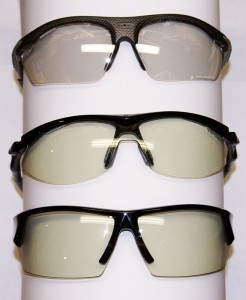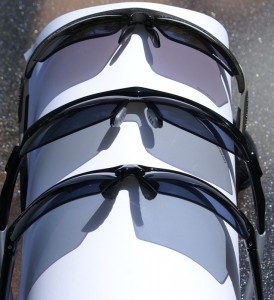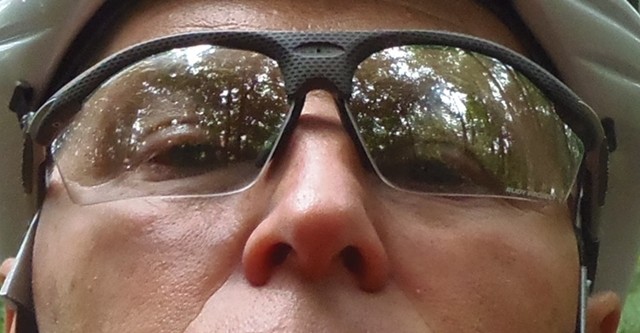
Sometimes, little details can make all the difference. Take mountain biking, just as an example. Everyone gets excited about the bike, and, maybe, the suspension, but details like seats, tires, gloves, shoes, helmets and even sunglasses can make riding easier and more fun. Like most lessons in life, I learned this the hard way. Years ago, when I was younger, stronger, and dumber (hah!) than I am now, I tried mountain bike racing. A number of broken bones later, I learned my lesson (strong, uncoordinated, and unskilled is a BAD combination); but in the process, I also learned that the ideal mountain biking glasses aren’t necessarily what you already own for road cycling.
MTB has a couple of challenges unique to the activity, and having the right glasses will make your rides safer and more fun. The first problem with mountain biking is the bumps. On the road, even a bumpy ride is pretty smooth; a rocky, rooty downhill on a mountain bike can not only jar the fillings out of your teeth, but the glasses off your face. Trying to ride well with the top of your glasses frame directly across the middle of your vision isn’t easy…or safe.
The second is that lighting varies dramatically, and usually at the worst possible time. You’re riding along a bright, sunny section, then suddenly pitch into a shaded downhill…and your dark “shades” pretty much turn everything black. Riding blind means either putting on the brakes fast so that you have time for your vision to adjust or…endo. And sometimes, one causes the other. At the other end of the spectrum, you can pretty much be blinded as you come out of a spruce forest into glaring sunlight without sunglasses. Neither situation is exactly optimal for smooth, fast, safe, fun riding. Regular sunglasses are simply too dark; lighter glasses are better, but are hard to find, and don’t necessarily work that well in the full range of conditions that you can run into.
After a number of aborted tries, I settled on what are known in the rarified world of biking optics as “clear photochromic lenses” as the ideal choice. These are lenses that have very little tint in low light, and still don’t get as dark as “regular” sunglasses even at their darkest; typically, they let in around 70% of available light when you’re in shaded areas, and around 20% in bright sun (typical sunglasses average more like 12% light transmission). Coupled with your eyes’ natural ability to adjust, that range means good vision for virtually all the lighting conditions you encounter on a typical mountain bike ride. Do they darken enough for a long road ride on a bluebird day, or for a bright day out on the water? Not really…they’ll work, but not that well. Would they be the ideal choice for a dark, rainy day ride? Again, not really; perfectly clear would be better. But as a compromise for 90%+ of your mountain bike rides, and many of your road rides, they’re by far the best thing our mountain bike testers have ever found.
Back “in the day,” I settled on a pair of Rudy Project Rydon frames with their ImpactX Photochromic Clear lenses. With a maximum light transmission of 78%, you almost don’t notice that they’re tinted; but with a minimum of 18%, they darken enough to keep you from going blind in full sun. I’m not going to say that they made my riding GOOD; that’s not possible. But they certainly improved it, and wearing them increased my confidence significantly.
Fast forward a number of years, has the state of the art changed, with new players? Rudy Project is still around and still producing the same excellent glasses; but have they updated anything? And, our test crew has had very good results with Ryders, a smaller brand that’s been around for about 25 years; their Treviso road photochromic is a great value. They have a light photochromic in the Caliber model, so we tested that. Finally, Tifosi has become one of the biggest players in sport glasses, and their road lenses are MUCH better than early versions we’d tested, where we’d found some quality control issues.Time to test! After a summer of passing them around our test team, here’s what we found.

Rudy Project Rydon w/ImpactX Photochromic Laser Clear lenses, $235 retail. Since my original pair, Rudy Project has brought out a new lens, the Laser Clear. There are two significant differences from the original; first is the light transmission, which, at 16-62% is a slightly narrower range and slightly darker overall than the original. We traded the two back and forth, and frankly didn’t notice that much difference in real world use, except that road riders enjoyed the new version more on bright days. We DID notice that everything looked hyper-sharp through the lenses…an almost surreal level of clarity that is the second improvement. Riders reported feeling more confident at riding fast through tricky sections, and loved the fast response as the lighting changed. And even though they are rated to allow less light in than the other two lenses (62% vs 76%), testers actually felt like they allowed more light in due to the razor sharpness. The frames came in for more of the same commentary; they’re sort of Gumby-like in their ability to be adjusted to fit different faces. Our fashionistas did some oohing and aahing over them, as well; they were a hot choice for coffee rides where everyone is paying attention to everyone else’s bikes and clothing. But, it was the clarity that really set them apart from everything else. These are the “if money is no object” choice; they’re dramatically more expensive than the others, but if you have the cash and want the best, they’re worth it. On one fast group ride, a professional showed up, and was wearing the Rydons…our tester commented that it must be nice to be sponsored by them, and the pro countered that he buys his own glasses. When asked why he chose these particulars ones, he simply said “because they’re the best.” ‘Nuff said. Balancing the price is Rudy’s warranty; 3 years on the frames, and if you scratch those gorgeous lenses, send them back and for 25 bucks they’ll send you new ones. If you are making a choice, buy the Kia Optima instead of the BMW 3-series and put some of the savings into these; you’ll get more enjoyment in the long run!
Ryders Caliber w/Light Gray Photochromic lenses, $80 retail. The Caliber is very different from the others; it has a sort of urban hipster chunky styling, rather than the sleek sports look of the other two.The advantage: most testers felt they blocked more light (and sometimes mud) from below than the other two. Disadvantage: some testers with smaller faces didn’t like the fit. Both the Ryders and Tifosi lenses go a different direction than the Rudy; rather than hyper-clear, they have a slight yellowish tint to increase contrast (Tifosi’s is slightly more pronounced). Clarity of the lenses was excellent; nobody noticed any lack of quality compared to other glasses in and out of the test until they put on the dramatically more expensive Rudys. Their 27-76% range would appear to be biased more toward being brighter than the Rudys, but the slight yellowness seemed to counteract that; in late afternoon, deep-conifer woods conditions, nobody felt that these gave an advantage. Except, of course, in price…for the same money as the Rydons, you can have a pair of these in your bike kit, one in your car, and yet another splashing around in your kayak! The only other complaint was the grippiness of the temple pieces; some testers had problems with them slipping on their faces when things were really bumpy. It wasn’t horrible, but these were just not quite as planted as the other glasses.
Tifosi Slip w/Light Night Fototec lenses, $70 retail. At slightly less expensive than the Ryders (and more often found at discount prices), the Slip is the serious bargain of the group. The lens light range is virtually identical to the Calibers at 27.7-75.9%, but the tint is slightly more yellow. Testers noticed that, describing them as “darker” in almost all conditions, and darker than the Rudys, as well; clearly, tint fools the eye as to how much light is actually getting in. While most riders gave the Ryders lenses a slight advantage, there wasn’t any question about the frames; everyone was blown away at the quality and fit of the Slip, especially for the money. On the rockiest, rootiest downhills, they stayed more planted, virtually as well as the highly customizable Rydons. Optical performance overall was at a slight disadvantage to the other two, in the eyes of our testers, but it was hard to quantify the difference; in real-world use, without trading them back and forth, these would simply look great.

Overall, we’re thrilled with what we found. A decade ago, clear photochromic glasses were a “what???”; now, they’re clearly in the mainstream. And should be; they’re incredibly useful for mountain biking, but can also be used pretty much across the board in all sports. They aren’t up to full-on glare from snow or beach sand, but they’ll handle everything short of that well enough. If your budget doesn’t allow multiple pairs of “good” glasses, you might consider them for your only pair. All of these glasses are worthy contenders; we’ve all happily used them in varying conditions. Across the board, testers felt that the Rudy Project Rydons merited their Beverly Hills price; the quality, the fit, the incredibly sharp optics, and the lens replacement warranty create short- and long-term value. If your budget doesn’t allow that extravagance, however, the choice between the Ryders Caliber and the Tifosi Slip is a little more difficult. For the die-hard MTB hammerhead, we’d choose the Tifosis; they stay on more faces without any tendency to slip at exactly the wrong moment. If, however, you’re a bit more moderate in your pursuits, and want something that’ll work like sport glasses but doesn’t quite as obviously say “I’m a bike geek,” something that’ll fit in with your Dockers or skinny jeans or protect your eyes from flying debris at the U2 concert (and just MIGHT have someone think you’re Bono, just for a few seconds)…well, the Ryders are right up your alley! Bottom line, though, is that any of them can make you a faster, safer MTB rider…and that’s really what we were looking for.


